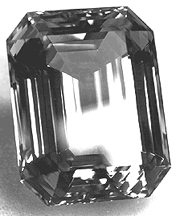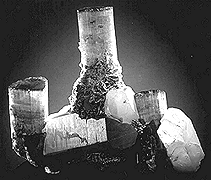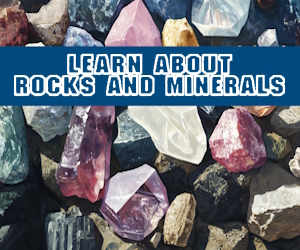English
Castellano
Català
Mineral Gemstones
Content by courtesy of : USGS
Reproduction of text and photos prohibited without permission of author.
Hardness and specific gravity are two of the major characteristics of gemstones.
Hardness of a gemstone is its resistance to scratching and may be described relative to a standard scale of 10 minerals known as the Mohs scale. F. Mohs, an Austrian mineralogist, developed this scale in 1822.
According to Mohs┬┤ scale, the hardness of--
Talc is 1
Gypsum is 2
Calcite is 3
Fluorite is 4
Apatite is 5
Feldspar is 6
Quartz is 7
Topaz is 8
Sapphire is 9
Diamond is 10
Specific gravity is the number of times heavier a gemstone of any volume is than an equal volume of water; in other words, it is the ratio of the density of the gemstone to the density of water.
The 16 mineral gemstone groups listed below are highly prized for their beauty, durability, and rarity:
Beryl (hardness: 7.5-8 Mohs)
Beryllium aluminum silicate
Specific gravity: 2.63-2.91 Emerald: Intense green or bluish green
Emerald: Intense green or bluish green
Aquamarine: Greenish blue or light blue
Morganite: Pink, purple pink, or peach
Heliodore: Golden yellow to golden green
Red beryl: Raspberry red
Goshenite: Colorless, greenish yellow, yellow green, brownish
Aquamarine, Brazil
Photograph courtesty of
The Smithsonian Institution
Chrysoberyl (hardness: 8.5 Mohs)
Beryllium aluminum oxide
Specific gravity: 3.68-3.78
Chrysoberyl: transparent yellowish green to greenish yellow and pale brown
Alexandrite: red in incandescent light and green in daylight
Cat┬┤s eye: usually yellowish or greenish
Corundum (hardness: 9 Mohs)
Aluminum oxide
Specific gravity: 3.96-4.05
Ruby: Intense red
Sapphire: Blue Diamond (hardness: 10 Mohs)
Diamond (hardness: 10 Mohs)
Carbon
Specific gravity: 3.51
Colorless to faint yellowish tinge, also variable
Diamond Star of Sierra Leone
Photograph courtesty of
The Smithsonian Institution
Feldspar (hardness: 6-6.5 Mohs)
Two distinctly different alkali alumino silicates: the Plagioclase and the Alkali Feldspar Series
Specific gravity: 2.55-2.76
Plagioclase Series-
Labradorite: Colorful, iridescent, also transparent stones in yellow, orange, red, and green
Sunstone: Gold spangles from inclusions of hematite
Peristerite: Blue white iridescence
Alkali Feldspar Group- Orthoclase: Pale yellow, flesh red
Amazonite: Yellow green to greenish blue
Moonstone: Colorless; also white to yellowish, and reddish to bluish gray
Garnet (hardness: 6.5-7.5 Mohs)
A group of silicate minerals
Specific gravity: 3.5-4.3
Almandine: Orangy red to purplish red
Almandine-spessartine: Reddish orange
Andradite: Yellowish green to orangy yellow to black
Demantoid: Green to yellow green andradite
Topazolite: Yellow to orangy yellow
Grossular: Colorless; also orange, pink, yellow, and brown
Tsavorite: Green to yellowish green
Hessonite: Yellow orange to red
Pyrope: Colorless; also pink to red
Chrome pyrope: Orange red
Pyrope-Almadine: Reddish orange to red purple
Pyrope-Spessartine: Greenish yellow to purple
Malaia: Yellowish to reddish orange to brown
Color-change garnet: Blue green in daylight to purple red in incandescent light
Rhodolite: Purplish red to red purple
Spessartine: Yellowish orange
Uvarovite: Emerald green
Jade (hardness: 6 Mohs)
Nephrite
Calcium magnesium silicate
Specific gravity: 2.9-3.1
White, deep green, creamy brown
Jadeite
Sodium aluminum silicate
Specific gravity: 3.1-3.5
White, leafy and blue green, emerald green, lavender, dark blue green and greenish black, deep emerald-green
Lapis lazuli (hardness: 5-5.5 Mohs)
A rock composed mainly of the mineral lazurite with variable amounts of pyrite (brassy flecks) and white calcite
Specific gravity: 2.7-2.9
Deep blue, azure blue, greenish blue (bluish color with flecks of white and gold)
Opal (hardness: 5.5-6.5 Mohs)
Hydrated silica
Specific gravity: 1.98-2.25
White opal: Opaque, porcelain-like white material; colors resemble flashes or speckles
Black opal: Flashes and speckles appear against black background
Water opal: A transparent, colorless opal is the background for brilliant flashes of color
Fire opal: Reddish or orange opal
Peridot [Olivine] (hardness: 7 Mohs)
Magnesium iron silicate
Specific gravity: 3.22-3.45
Olive to lime green
Quartz (hardness: 7 Mohs)
Silicon dioxide or silica
Specific gravity: 2.65
 Coarsely crystalline varieties of silica-
Coarsely crystalline varieties of silica-
Rock crystal: Colorless
Amethyst: Purple
Citrine: Yellow to amber
Morion: Black
Smoky quartz or cairngorm: smoky gray to brown
Rose quartz: Translucent pink
Green quartz or praziolite: Green
Candelabra: white quartz, blue-capped red elbaite, and tan albite, California
Photograph courtesty of
The Smithsonian Institution
Cryptocrystalline varieties of silica-
Chalcedony and Jasper (variable)
Agate: Bull┬┤s eye agate, Iris or fire agate, Onyx, Sardonyx. Bloodstone or heliotrope. Carnelian. Chrysoprase. Moss agate. Plasma. Prase. Sard. Jasper.
Spinel (hardness: 8 Mohs)
Magnesium aluminum oxide
Specific gravity: 3.58-4.06
Balas ruby: Red
Almandine spinel: Purple red
Rubicelle: Orange
Sapphire spinel and ghanospinel: Blue
Chlorspinel: Green
Topaz (hardness: 8 Mohs)
Aluminum silicate fluoride hydroxide
Specific gravity: 3.5-3.6
Wine yellow, pale blue, green, violet, or red
Tourmaline (hardness: 7-7.5 Mohs)
Complex aluminum borosilicate
(Elbaite, Dravite, Uvite)
Specific gravity: 3.03-3.25
Achorite: Colorless
Brazilian emerald: Green
Dravite: Brown
Indicolite: Dark blue
Rubellite: Pink to red
Siberite: Violet
Verdilite: Green
Turquoise (hardness: 5-6 Mohs)
Hydrous copper aluminum phosphate
Specific gravity: 2.6-2.8
Sky blue; greenish blue
Zircon (hardness: 7.5 Mohs)
Zirconium silicate
Specific gravity: 4.6-4.7
Jargon: Variable
Matura diamond: Colorless
Hyacinth: Yellow, orange, red, brown
Information | Mineral photos | VIDEOS | Articles | Fairs | Web directory | Classified ads | Minerals Books | Shop



